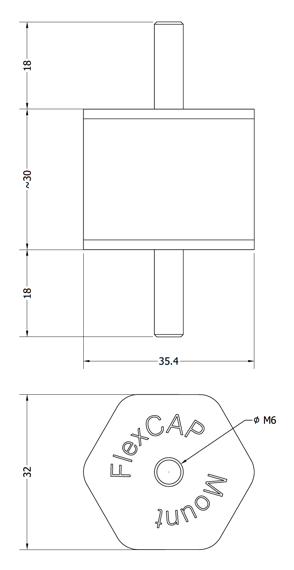| PRODUCT | Load range | Load per mount | Compression at load | Reduction starts at |
| [kg/mount] | [kg/mount] | [mm], approx. | [Hz] approx. | |
| FlexCAP Mount Blue | 0.5 – 2 | 0.5 | 0.5 | > 22 |
| VCSS-037934 | 1 | 0.9 | > 15 | |
| VCSS-037934FB | 2 | 3.9 | > 12 | |
| FlexCAP Mount Purple | 2 – 4.5 | 2.5 | 1.0 | > 20 |
| VCSS-037935 | 3.5 | 1.9 | > 18 | |
| VCSS-037935FB | 4.5 | 2.7 | > 15 | |
| FlexCAP Mount Black | 4 – 5.5 | 4.5 | 3.0 | > 18 |
| VCSS-037936 | 5 | 3.5 | > 16 | |
| VCSS-037936FB | 5.5 | 4.0 | > 15 | |
| FlexCAP Mount Orange | 5.5 – 8.5 | 5.5 | 1.9 | > 22 |
| VCSS-037937 | 7 | 2.7 | > 20 | |
| VCSS-037937FB | 8.5 | 3.4 | > 18 |
NOTE: it is assumed the centre of gravity (COG) is at the centre of the part which needs to be resilient mounted.
*This is a complex matter though there are some guidelines. With rotating machinery, take the constant or lowest revolutions (rpm) and divide by 60 (s), this gives the lowest possible disturbing frequency. Another good indicator is an actual vibration measurement from the unit itself, first distinct peak will give you the lowest disturbing frequency. In case of non-rotating vibrating units (like exhaust silencer), determine the lowest disturbing frequency from the source it is attached to (classic example 4-cylinder diesel generator at 1500 rpm constant velocity: 1500/60 = 50 Hz).

